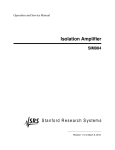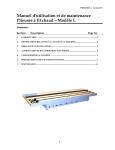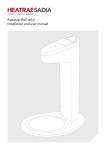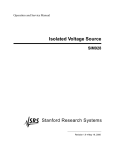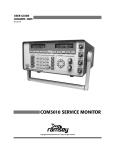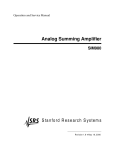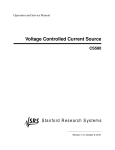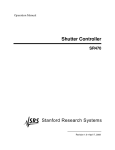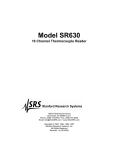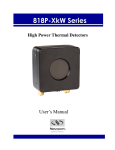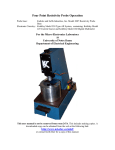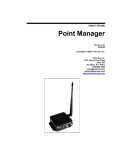Download SIM918 Precision Current Preamplifier
Transcript
Operation and Service Manual Precision Current Preamplifier SIM918 Stanford Research Systems Revision 1.8 • December 13, 2006 Certification Stanford Research Systems certifies that this product met its published specifications at the time of shipment. Warranty This Stanford Research Systems product is warranted against defects in materials and workmanship for a period of one (1) year from the date of shipment. Service For warranty service or repair, this product must be returned to a Stanford Research Systems authorized service facility. Contact Stanford Research Systems or an authorized representative before returning this product for repair. Information in this document is subject to change without notice. c Stanford Research Systems, Inc., 2006. All rights reserved. Copyright Stanford Research Systems, Inc. 1290–D Reamwood Avenue Sunnyvale, CA 94089 USA Phone: (408) 744-9040 • Fax: (408) 744-9049 www.thinkSRS.com • e-mail: [email protected] Printed in U.S.A. Document number 9-01592-903 SIM918 Precision Current Preamplifier Contents General Information Safety and Preparation for Use Symbols . . . . . . . . . . . . . Notation . . . . . . . . . . . . . Specifications . . . . . . . . . . 1 2 3 4 . . . . . . . . . . . . . . . . . . . . . . . . Getting Started 1.1 Introduction to the Instrument . . . 1.2 Front-Panel Operation . . . . . . . . 1.3 Connections . . . . . . . . . . . . . . 1.4 Power-On . . . . . . . . . . . . . . . 1.5 Restoring the Default Configuration 1.6 SIM Interface . . . . . . . . . . . . . . Description of Operation 2.1 About Transimpedance Amplifiers 2.2 Bias and Ground . . . . . . . . . . 2.3 Output . . . . . . . . . . . . . . . . 2.4 Autozero Trim . . . . . . . . . . . . 2.5 Phase-Locked Loop . . . . . . . . . 2.6 Autocalibration . . . . . . . . . . . 2.7 Clock Stopping . . . . . . . . . . . 2.8 Quiescent Operation . . . . . . . . Remote Operation 3.1 Index of Common Commands . 3.2 Alphabetic List of Commands . 3.3 Introduction . . . . . . . . . . . 3.4 Commands . . . . . . . . . . . . 3.5 Status Model . . . . . . . . . . . . . . . . . . . . . . . . . . . . . . . . . . . . . . . . . . . . . . . . . . . . . . . . . . . . . . . . . . . . . . . . . . . . . . . . . . . . . . . . . . . . . . . . . . . . . . . . . . . . . . . . . . . . . . . . . . . . . . . . . . . . . . . . . . . . . . . . . . . . . . . . . . . . . . . . . . . . . . . . . . . . . . . . . . . . . . . . . . . . . . . . . . . . . . . . . . . . . . . . . . . . . . . . . . iii iii vi vii vii . . . . . . . . . . . . . . 1–1 . 1–2 . 1–5 . 1–8 . 1–9 . 1–9 . 1 – 10 . . . . . . . . 2–1 . 2–2 . 2–4 . 2–5 . 2–5 . 2–6 . 2–6 . 2–7 . 2–8 . . . . . 3–1 . 3–2 . 3–4 . 3–6 . 3–7 . 3 – 24 Circuit Description 4–1 4.1 Schematic Diagrams . . . . . . . . . . . . . . . . . . . 4 – 2 A Index A–1 i ii Contents SIM918 Precision Current Preamplifier General Information The SIM918 Precision Current Preamplifier, part of Stanford Research Systems’ Small Instrumentation Modules family, converts an input electric current into a proportional voltage output while maintaining zero potential difference between the input terminal and a bias terminal. The main amplifier stage presents a transimpedance RF , equal to the current gain of the preamplifier, to an input current iin . The bias voltage Vbias is subtracted from the output of the stage, so that the voltage at the output of the instrument is Vout = (Vbias − iin × RF ) − Vbias = −iin × RF . Safety and Preparation for Use Connections No dangerous voltages are generated by the module. However, the outer shield of the front-panel Input coaxial (BNC) connector in the SIM918 can be switched to the rear-panel Program input. If a dangerous voltage is applied to the Program terminal, it may be present on the outer shell of the Input connector, and may cause injury or death. WARNING Do not exceed ±60 volts to the Earth at the center terminal of the rear-panel Shield Program Voltage BNC connector. CAUTION Do not exceed ±15 volts to the Earth at the center terminal of the front-panel Input and Bias BNC connectors, or at the center terminal of the rear-panel Ref Clock Sync BNC connector. Biomedical applications WARNING Under certain conditions, the SIM918 may prove to be unsafe for applications involving human subjects. Incorrect grounding, component failure, and excessive common-mode input voltages are examples of conditions in which the instrument may expose the subject iii iv General Information to large input currents. Therefore, Stanford Research Systems does not recommend the SIM918 for such applications. Caution regarding use with photomultipliers CAUTION The front-end amplifier of this instrument is easily damaged if a photomultiplier is used improperly with the preamplifier. When left completely unterminated, a cable connected to a PMT can charge to several hundred volts in a relatively short time. If this cable is connected to the curent input of the SIM918, the stored charge may damage the front-end JFET. To avoid this problem, provide a leakage path of about 100 kΩ to ground inside the base of the PMT to prevent charge accumulation. Service Do not install substitute parts or perform unauthorized modifications to this instrument. Preparation for use The SIM918 is a single-wide module designed to be used inside the SIM900 Mainframe. Do not turn on the power to the mainframe or apply voltage or current inputs to the module until the module is completely inserted into the mainframe and locked in place. SIM918 Precision Current Preamplifier General Information SIM918 Precision Current Preamplifier v vi General Information Symbols you may Find on SRS Products Symbol Description Alternating current Caution - risk of electric shock Frame or chassis terminal Caution - refer to accompanying documents Earth (ground) terminal Battery Fuse On (supply) Off (supply) SIM918 Precision Current Preamplifier General Information vii Notation The following notation will be used throughout this manual: WARNING A warning means that injury or death is possible if the instructions are not obeyed. CAUTION A caution means that damage to the instrument or other equipment is possible. Typesetting conventions used in this manual are: • Front-panel buttons are set as [GAIN ]; [GAIN ] is shorthand for “[GAIN ] & [GAIN ]”. • Front-panel indicators are set as OVLD. • Signal names are set as ¬STATUS. • Signal levels are set as HIGH. • Remote command names are set as *IDN? . • Literal text other than command names is set as OFF. • Special ASCII characters are set as hCRi. Remote command examples will all be set in monospaced font. In these examples, data sent by the host computer to the SIM918 are set as straight teletype font, while responses received by the host computer from the SIM918 are set as slanted teletype font. SIM918 Precision Current Preamplifier viii General Information Specifications Performance characteristics Min Gain Selection Accuracy, 106 V/A 107 V/A 108 V/A Stability, 106 V/A 107 V/A 108 V/A Current input Selection Offset voltage [1–3] Resistance Capacitance Bias current, DC [3] AC [1, 4] Current noise at 1 kHz [5], 106 V/A 107 V/A 108 V/A Voltage noise [1, 4] −3 dB bandwidth [5], 106 V/A 107 V/A 108 V/A Terminals BNC shield Bias input Selection Voltage [7] Resistance −3 dB bandwidth Terminals BNC shield Program input Voltage Resistance Terminals Reference clock sync Selection Interface Input frequency [10] Output frequency SIM918 Typ Max 106 , 107 , 108 ±0.1 ±0.1 ±1 ±10 ±50 ±100 Units V/A % % % ppm/◦ C ppm/◦ C ppm/◦ C On, open ±10 µV 1 Ω 18 pF 0.5 2.0 pA 3.5 pA rms √ 130 fA/ Hz √ 42 fA/ Hz √ 15 fA/ Hz 25 µV rms 22 kHz 12 kHz 4 kHz Isolated BNC [6] Ground, bias, program /open On, ground −5.0 +5.0 V 10 MΩ 0.2 Hz Isolated BNC [6] Ground, float −60 +60 V 3 GΩ Grounded BNC [8], rear Input, output Rear BNC [8], TTL [9] 0.90 1.10 Hz 1.0 Hz Precision Current Preamplifier General Information ix Min Autozero Selection Source Switching frequency Output Voltage [7] Maximum current Short circuit duration Resistance Offset voltage [2] Common-mode rejection, DC Terminals Operating Temperature [11] Power Supply current, +5 V ±15 V Typ Max Units On, hold Internal, external reference clock 0.50 Hz +10.0 −10.0 ±100 80 V mA Indefinite 100 Ω ±50 µV dB Grounded BNC [6] 0 40 +5, ±15 100 150 ◦C V DC mA mA Conditions: [1] With autozero on. [2] Following an autocalibration at (23 ± 5) ◦ C within 24 hours. [3] 100 s average. [4] 0.1 Hz to 10 Hz. [5] For a 100 pF source capacitance and an infinite source resistance. Higher values of source capacitance or a finite source resistance will degrade these specifications. [6] Amphenol 31–10–4052 or similar. [7] An overload will be detected and the instrument is not guaranteed to perform properly if these limits are exceeded, or if |Vbias − iin × RF | exceeds the limits. Continuous application of a bias voltage Vbias in excess of ±15 V will damage the instrument. [8] Tyco 227169–4 or similar. [9] Rising-edge sensitive. [10] External reference clock capture range. The instrument is not guaranteed to perform properly if these limits are exceeded. [11] Non-condensing. General characteristics Interface Connectors Weight Dimensions SIM918 Precision Current Preamplifier Serial (RS–232) through SIM interface BNC (3 front [4], 2 rear [6]); DB–15 (male) SIM interface 1.7 lbs 1.500 W × 3.600 H × 7.000 D x General Information SIM918 Precision Current Preamplifier 1 Getting Started This chapter gives you the necessary information to get started quickly with your SIM918 Precision Current Preamplifier. In This Chapter 1.1 1.2 1.3 1.4 1.5 1.6 Introduction to the Instrument . . . . . 1.1.1 Current amplifiers and autozero 1.1.2 Clocks . . . . . . . . . . . . . . . 1.1.3 Cabling and grounding . . . . . 1.1.4 Autocalibration . . . . . . . . . . 1.1.5 Remote interface and status . . . 1.1.6 Block diagram . . . . . . . . . . . 1.1.7 Front and rear panels . . . . . . . Front-Panel Operation . . . . . . . . . . 1.2.1 Gain . . . . . . . . . . . . . . . . 1.2.2 Autozero . . . . . . . . . . . . . . 1.2.3 Input . . . . . . . . . . . . . . . . 1.2.4 Bias . . . . . . . . . . . . . . . . . 1.2.5 Output overload . . . . . . . . . Connections . . . . . . . . . . . . . . . . Power-On . . . . . . . . . . . . . . . . . Restoring the Default Configuration . SIM Interface . . . . . . . . . . . . . . . 1.6.1 SIM interface connector . . . . . 1.6.2 Direct interfacing . . . . . . . . . . . . . . . . . . . . . . . . . . . . . . . . . . . . . . . . . . . . . . . . . . . . . . . . . . . . . . . . . . . . . . . . . . . . . . . . . . . . . . . . . . . . . . . . . . . . . . . . . . . . . . . . . . . . . . . . . . . . . . . . . . . . . . . . . . . . . . . . . . . . . . . . . . . . . . . . . . . . . . . . . 1–2 1–2 1–2 1–3 1–3 1–3 1–4 1–5 1–5 1–5 1–5 1–7 1–7 1–8 1–8 1–9 1–9 1 – 10 1 – 10 1 – 10 1–1 1–2 1.1 1.1.1 Getting Started Introduction to the Instrument Current amplifiers and autozero A current, or transimpedance, amplifier converts electric current into a proportional output voltage. Unlike a simple resistor, the amplifier presents a low-impedance terminal to the input current. In the SIM918 Precision Current Preamplifier, the electric potential of the input terminal, Vin , is accurately made equal to the user-provided offset voltage potential at the bias terminal, Vbias , or to ground. The absolute magnitude of the resulting input offset voltage is nearly zero: Vofs = Vin − Vbias , |Vofs | < 10 µV. In all transimpedance amplifiers, the input potential is kept near that of the bias through the action of negative feedback. When the bias voltage is at ground, the input terminal is often said to present virtual ground a virtual ground, or a virtual null. Without autozeroing, this virtual ground drifts, in some cases by many millivolts. This error in the electric potential of the input terminal may be unacceptable in precision measurements. In the SIM918, an autozero circuit measures Vofs every 2 seconds and makes the adjustment necessary to keep the offset voltage at zero. The autozero feature can be engaged or inhibited remotely or from the front panel, giving the user flexibility in sensitive applications. With autozero inhibited, the preamplifier retains microvolt input accuracy for many hours. When engaged, it takes the autozero only a few cycles of a reference clock to restore the offset to within its specified limits. The gain, or transimpedance, of the preamplifier can be set to RF = 106 , 107 , or 108 V/A, remotely and from the front panel. Along with voltage accuracy, the SIM918 offers a low input bias current1 and a current noise that is close to the lower limit imposed by the Johnson noise of the transimpedance. 1.1.2 Clocks The autozero circuit switches between measuring the input offset voltage, and the offset voltage of the zeroing amplifier itself, at one reference clock half the frequency of an internal or external reference clock. The inone pps ternal clock signal (typically 1.0 pulse per second, pps, i.e. 1.0 Hz) can be selected, remotely or from the front panel, to be output on 1 In the unfortunate but established terminology of electronics, the word bias conveys different meanings. The bias current is the input current present in the instrument in the absence of a current from an external source. SIM918 Precision Current Preamplifier 1.1 Introduction to the Instrument 1–3 a rear-panel connector. Alternatively, the same connector can be used to input a clock signal at (1.0 ± 10%) pps (i.e. 1.10 Hz–0.90 Hz), synchronizing the switching to an external source. The reference clock in the SIM918 operates independently of the oscillator used to clock the digital control circuitry. The latter is designed with a special clock-stopping architecture. The microcontroller is turned on only in the following cases: when the settings are being changed; autozero is turned on or off; and during autocalibration, remote communications, or when an overload condition or an external reference clock event occurs. This guarantees that no digital noise contaminates low-level analog signals. With autozero off and in the absense of an external clock input, the preamplifier enters a completely quiescent state: no reference clock transitions are present that can disturb the measurement of a low-level electric current. 1.1.3 Cabling and grounding The SIM918 provides maximum flexibility for cabling and grounding. The input connection can be opened, and the bias voltage can be connected to signal ground. The shield of the Input BNC can be switched between signal ground, the bias voltage, or the rear-panel Program input (which can be left floating, if desired). With the Program input, a user can supply an excitation potential to an experiment via the shield conductor of the input cable, while the excited current flows through the center conductor to the SIM918. The shield of the Bias BNC can be independently grounded or floated. The input and bias selections, and those of their shields, can be made via the push of a front-panel button or remotely. 1.1.4 Autocalibration A user-commanded autocalibration procedure allows one to eliminate the effects of thermal drifts in the autozero circuit, and to reduce output offset voltage. 1.1.5 Remote interface and status remote interface A remote computer can access the module through the SIM900 Main- frame, using RS–232 or GPIB. All instrument settings can be queried via the remote interface. The SIM918 can be operated outside the SIM900 Mainframe by powering it with its required DC voltages. SIM918 Precision Current Preamplifier 1–4 Getting Started If the maximum bias voltage is exceeded, or the chosen gain setting causes the output voltage to exceed its maximum, the appropriate overload LED turns on. If the module cannot lock to an external reference clock signal, an LED indicates an unlocked state. If armed, the module also generates a status signal to alert the user of the overload or unlocked condition. 1.1.6 Block diagram The output of the main amplifier (transimpedance stage) is referenced to the bias voltage. A difference amplifier subtracts the bias voltage, so the output of the instrument is directly proportional to the input current iin and the gain RF : Vout = (Vbias − iin × RF ) − Vbias = −iin × RF . (1.1) A block diagram of the preamplifier is shown below in Figure 1.1. RF INPUT − BIAS + Main amp offset adj + − − + OUTPUT Difference amp LPF Zeroing amp (±1) 0.5 Hz Figure 1.1: The SIM918 block diagram. SIM918 Precision Current Preamplifier 1.2 Front-Panel Operation 1.1.7 1–5 Front and rear panels Figure 1.2: The SIM918 front and rear panels. 1.2 Front-Panel Operation 1.2.1 Gain The gain RF of the preamplifier, in volts per microampere, is indicated on the front panel of the instrument via a green annunciator LED.2 Press one of the [GAIN ] buttons to change the gain. If [GAIN ] is pressed when RF = 1 V/µA, the press has no effect. If [GAIN ] is pressed when RF = 100 V/µA, the press has no effect. A simultaneous press of [GAIN ] has a special meaning. This press initiates autocalibration (Section 2.6). 1.2.2 Autozero 1.2.2.1 Engaging the autozero circuit The autozero circuit is turned ON by the press of a front-panel button. There will be a pause of up to 3.3 seconds (a wait for a positive-going edge of the reference clock). At the end of the pause, the green 2 SIM918 Note the minus sign in Eq. (1.1); the output voltage is positive for a current that flows out of the input terminal. Precision Current Preamplifier 1–6 Getting Started annunciator LED will turn on and the zeroing circuit will become active. The same button turns autozeroing off. There will be a less than 1 s pause in order for the present control output of the autozero circuit to be sampled and stored. At the end of the pause, the LED indicator will turn off and all switching inside the SIM918 will cease. The sampled control output (trim) will remain applied to the transimpedancestage amplifier, zeroing it to the best of precision available at the time the autozero circuitry is inhibited. 1.2.2.2 Reference clock detection The autozero circuit switches at one half the frequency of an internal or external reference clock. If a periodic TTL-level signal is applied to the rear-panel Ref Clock Sync connector, and the connector is not selected for output (see the next section), the preamplifier will recognize the external clock and attempt to lock to the signal. The green External LED will illuminate for the duration of the external clock input. capture range If the frequency of the external clock is stable and is between 0.90 Hz lock acquisition time and 1.10 Hz, the module will successfully lock to the signal. It typically takes 250 s (just over 4 minutes) to acquire a lock. The yellow Unlocked LED is illuminated whenever the SIM918 is not in a locked state. For further discussion of locking, see Chapter 2.5. For the duration of an unlocked state, the switches in the autozero circuit are not guaranteed to have correct duty cycles. Therefore, the specified input offset accuracy is not guaranteed while Unlocked. The internal reference clock is used when an external clock signal is not present. In this state, neither the External LED nor the Unlocked LED is illuminated. 1.2.2.3 Output 1 pps sync The rear-panel Ref Clock Sync connector can be used to output the internal reference clock. The signal at the output is TTL, typically at 1.0 Hz (1.0 pps). The [Output 1 pps sync] button toggles the direction of the signal at the rear-panel connector. The output direction is indicated by a green LED. An inactive Output 1 pps sync indicates that the connector may be used to input an external clock. If [Output 1 pps sync] is pressed while an external reference clock signal is present at the connector, clock output will fail and a DeviceDependent Error (Section 3.5.3) will be issued. If an external signal is applied to the Ref Clock Sync terminal while the connector is selected for output, the external signal will not be recognized. SIM918 Precision Current Preamplifier 1.2 Front-Panel Operation 1.2.3 1–7 Input The [INPUT Open] button opens and closes a relay in the path of the input current. A green LED indicates a disconnected input terminal. The input capacitance of the SIM918 is at its lowest with input open, and is specified in the table on Page viii. 1.2.3.1 Input shield Successive presses of the [INPUT Shield] button connect the outer shell of the Input BNC to the rear-panel Shield Program Voltage terminal, a buffered copy of the bias voltage, and to signal ground. The state of the input shield connection is indicated by one of three LEDs: the yellow INPUT Shield Prog, the yellow INPUT Shield Bias, or the green INPUT Shield GND. To float the shield of the Input connector, leave the Shield Program Voltage BNC open and select INPUT Shield Prog. 1.2.4 Bias The [BIAS GND] button toggles the source of the bias between the voltage at the center terminal of the Bias BNC and the signal ground of the instrument. If the bias source is set to ground, the green BIAS GND light is on. With Bias grounded, the difference amplifier (Figure 1.1) is switched out and the output of the instrument is taken directly from the transimpedance stage. With this configuration, there is no common-mode error and the output-offset error is reduced. When Bias is connected to a user voltage, the voltage is buffered internally before being distributed to other parts of the preamplifier. The offset error of the bias buffer is included in the input offset accuracy specifications in the table on Page viii. 1.2.4.1 Bias overload An overload condition is recognized and the BIAS OVLD LED is activated if the absolute value of the voltage applied to the Bias bias overload limits input exceeds certain limits. These limits are typically ±5.0 V, and are between −5.2 V ≤ Vmin ≤ −4.9 V, 4.9 V ≤ Vmax ≤ 5.2 V. The overload LED stays on for a minimum of 50 ms; after this time it turns off if the overload condition has ceased. SIM918 Precision Current Preamplifier 1–8 Getting Started 1.2.4.2 Bias shield Successive presses of the [BIAS Shield] button float the outer shell of the Bias BNC and connect it to ground. The state of the bias shield connection is indicated by one of two LEDs: the yellow BIAS Shield Float or the green BIAS Shield GND. Note that it is the electric potential at the Bias terminal, not the potential difference across the Bias connector, that the autozero circuit uses as the reference for the input voltage. 1.2.5 Output overload An overload condition is recognized and the OUTPUT OVLD LED is activated if the absolute value |iin ×RF | exceeds certain limits. These output overload limits limits are typically ±10.0 V, and are between −10.4 V ≤ Vmin ≤ −9.9 V, 9.9 V ≤ Vmax ≤ 10.4 V. The overloaded state is also recognized, and OUTPUT OVLD activated, if the raw output of the transimpedance stage, |Vbias − iin × RF |, exceeds these limits. To distinguish between the two output overload possibilities, use the OVLD? query. The overload LED stays on for a minimum of 50 ms; after this time it turns off if the overload condition has ceased. 1.3 Connections There are five BNC connectors in the SIM918, three on the front panel and two at the rear. Panel BNC Front Input Terminal Bias Output Rear Shield Program Voltage Ref Clock Sync Signal Direction Center Input current Input Shield Shield program voltage, bias voltage, signal ground Output Center Bias voltage Input Shield Float, power ground Center Output voltage Output Shield Signal ground Output Center Shield program voltage Input Shield Chassis ground Center Reference clock Input, output Shield Chassis ground Input, output Table 1.1: BNC connections in the SIM918. For a further discussion of grounding, see Section 2.2.1. The SIM interface connector is discussed in Section 1.6.1. SIM918 Precision Current Preamplifier 1.4 1.4 Power-On 1–9 Power-On The instrument retains the following settings in non-volatile memory: 1. The power line frequency (FPLC): 60 Hz or 50 Hz.3 2. The gain. 3. Autozero on/off. 4. Input selection (on, open). 5. Input shield selection (program, bias, ground.) 6. Bias selection (on, ground). 7. Bias shield selection (float, ground.) 8. Whether or not the phase-locked loop (Section 2.5) stays active when autozero is off. 9. Calibration values. The power-on configuration of the remote interface is detailed in Section 3.3.1. 1.5 Restoring the Default Configuration The default configuration of the SIM918 is: 1. Gain 106 V/A. 2. Autozero on. 3. Input connected. 4. Input shield at ground. 5. Bias at ground. 6. Bias shield at ground. 7. Reference clock direction is input. 8. The phase-locked loop (Section 2.5) is inactive when autozero is off. To reset the module into this configuration, turn the SIM900 Mainframe power on while holding a front-panel button of the SIM918 for at least 2.0 seconds. The same configuration can also be reached from the remote interface by issuing the *RST command. 3 SIM918 FPLC equals the principal rejection frequency of an internal analog-to-digital converter used to measure the input offset trim. See the command OFST. Precision Current Preamplifier 1 – 10 1.6 Getting Started SIM Interface The primary connection to the SIM918 Precision Current Preamplifier is the rear-panel DB–15 SIM interface connector. Typically, the SIM918 is mated to a SIM900 Mainframe via this connection, either through one of the internal mainframe slots or the remote cable interface. It is also possible to operate the SIM918 directly, without using the SIM900 Mainframe. This section provides details on the interface. 1.6.1 SIM interface connector The DB–15 SIM interface connector carries all the power and communication lines to the instrument. The connector signals are specified in Table 1.2. Pin 1 2 3 4 5 6 7 8 9 10 11 12 13 14 15 Direction Src ⇒ Dest Signal SIGNAL GND ¬STATUS RTS CTS ¬REF 10MHZ −5V −15V PS RTN CHASSIS GND TXD RXD REF 10MHZ +5V +15V +24V MF ⇒ SIM SIM ⇒ MF MF ⇒ SIM SIM ⇒ MF MF ⇒ SIM MF ⇒ SIM MF ⇒ SIM MF ⇒ SIM MF ⇒ SIM SIM ⇒ MF MF ⇒ SIM MF ⇒ SIM MF ⇒ SIM MF ⇒ SIM Description Signal ground Status/service request (GND = asserted, +5 V= idle) HW handshake (unused in SIM918) HW handshake (unused in SIM918) 10 MHz reference (no connection in SIM918) Power supply (no connection in SIM918) Power supply Power ground Chassis ground Async data (start bit = “0”= +5 V; “1” = GND) Async data (start bit = “0”= +5 V; “1” = GND) 10 MHz reference (no connection in SIM918) Power supply Power supply Power supply (no connection in SIM918) Table 1.2: SIM interface connector pin assignments, DB–15. 1.6.2 Direct interfacing The SIM918 is intended for operation in the SIM900 Mainframe, but users may wish to directly interface the module to their own systems without the use of additional hardware. The mating connector needed is a standard DB–15 receptacle, such as Tyco part number 747909–2 (or equivalent). Clean, well-regulated supply voltages of ±15.0 V DC, +5.0 V DC must be provided, following the pinout specified in Table 1.2 and the minimum currents in the table on Page ix. Ground must be provided on Pins 1 and 8, with chassis ground on Pin 9. The ¬STATUS signal may be monitored SIM918 Precision Current Preamplifier 1.6 SIM Interface 1 – 11 on Pin 2 for a low-going TTL-compatible output indicating a status message. See Section 3.5 for the description of status messages. CAUTION 1.6.2.1 The SIM918 has no internal protection against reverse polarity, missing supply, or overvoltage on the +5 V and the ±15 V power-supply pins. Supply voltages above 5.5 V on Pin 13, above +16 V on Pin 14, or below −16 V on Pin 7 are likely to damage the instrument. SRS recommends using the SIM918 together with the SIM900 Mainframe for most applications. Direct interface cabling If the user intends to directly wire the SIM918 independent of the SIM900 Mainframe, communication is usually possible by directly connecting the appropriate interface lines from the SIM918 DB–15 plug to the RS–232 serial port of a personal computer.4 Connect RXD from the SIM918 directly to RxD on the PC, TXD directly to TxD. In other words, a null-modem-style cable is not needed. To interface directly to the DB–9 male (DTE) RS–232 port typically found on contemporary personal computers, a cable must be made with a female DB–15 socket to mate with the SIM918, and a female DB–9 socket to mate with the PC’s serial port. Separate leads from the DB–15 need to go to the power supply, making what is sometimes know as a “hydra” cable. The pin connections are given in Table 1.3. DB–15/F to SIM918 Name DB–9/F 10 ←→ 3 11 ←→ 2 5 TxD RxD Computer Ground to Power Supply 7 ←→ 13 ←→ 14 ←→ 1 ←→ 8 ←→ 9 ←→ −15 V DC +5 V DC +15 V DC Signal Ground (separate wire to Ground) Power Ground (separate wire to Ground) Chassis Ground (separate wire to Ground) Table 1.3: SIM918 direct interface cable pin assignments. note about grounds The distinct Signal Ground and Power Ground, and the chassis ground, are not directly connected within the SIM918. The power 4 SIM918 Although the serial interface lines on the DB–15 do not satisfy the minimum voltage levels of the RS–232 standard, these lines are typically compatible with desktop personal computers. Precision Current Preamplifier 1 – 12 Getting Started ground carries the return currents of digital control signals, powerintensive analog amplifiers, and the power supplies, whereas the output voltage references to a stable signal ground (Section 2.2.1). When operating in the SIM900, the three grounds are tied together in the SIM900 Mainframe. Signal Ground and Power Ground are connected through back-to-back Schottky diodes, so they cannot be more than ∼ ±0.35 V apart. The three ground lines should be separately wired to a single, low-impedance ground source at the power supply. 1.6.2.2 Serial settings The initial serial port settings at power-on are: baud rate 9600, 8 bits, no parity, 1 stop bit, and no flow control. The baud rate of the SIM918 cannot be changed. Flow control is not implemented in the SIM918. The parity may be changed with the PARI command. SIM918 Precision Current Preamplifier 2 Description of Operation This chapter provides a number of additional details of the operation of the SIM918. In This Chapter 2.1 2.2 2.3 2.4 2.5 2.6 2.7 2.8 About Transimpedance Amplifiers . 2.1.1 Input capacitance and stability 2.1.2 Choosing the right gain . . . . Bias and Ground . . . . . . . . . . . . 2.2.1 Grounds . . . . . . . . . . . . . 2.2.2 Bias . . . . . . . . . . . . . . . . Output . . . . . . . . . . . . . . . . . . Autozero Trim . . . . . . . . . . . . . . Phase-Locked Loop . . . . . . . . . . . Autocalibration . . . . . . . . . . . . . Clock Stopping . . . . . . . . . . . . . Quiescent Operation . . . . . . . . . . . . . . . . . . . . . . . . . . . . . . . . . . . . . . . . . . . . . . . . . . . . . . . . . . . . . . . . . . . . . . . . . . . . . . . . . . . . . . . . . . . . . . . . . . . . . . . . . . . . . . . . . . . . . . 2–2 2–2 2–3 2–4 2–4 2–4 2–5 2–5 2–6 2–6 2–7 2–8 2–1 2–2 2.1 Description of Operation About Transimpedance Amplifiers transimpedance amplifier A transimpedance amplifier is an operational amplifier with a resistor in the feedback path. More generally, the feedback impedance ZF always has a resistive and a reactive component. The two inputs to the operational amplifier have a very high impedance; and the feedback in the amplifier acts to keep the two inputs at the same electric potential. Therefore, the input current iin is forced through the feedback impedance, and the amplifier produces an output voltage Vout, TA = Vbias − iin × ZF . The amplifier acts to translate the input current into a proportional output voltage, with the feedback impedance being the coefficient of proportionality. Hence the term transimpedance. The main amplifier of the SIM918 Precision Current Preamplifier is a transimpedance amplifier based on a composite, JFET-input design. 2.1.1 Input capacitance and stability The input impedance of JFET devices is extremely large. However, the impedance experienced, as a whole, by a current input to the feedback amplifier (i.e. the change in the input voltage1 divided by the input current) has two other, much more significant contributions in parallel. The first one is the effect of the output on the input via feedback due to finite open-loop voltage gain of the operational amplifier, and the second one is input capacitance. CF RF Input BNC i in Vout, TA C in Op-amp (F) Z in Bias Bias Figure 2.1: A transimpedance amplifier. The first term equals the feedback impedance divided by the openloop gain of the operational amplifier2 : (F) Zin = ZF /AOL 1 2 (2.1) Without the action of the autozero circuit. Within the current bandwidth of the transimpedance amplifier. SIM918 Precision Current Preamplifier 2.1 About Transimpedance Amplifiers 2–3 and is below 1 Ω at DC. The open-loop gain is very high at DC, and typically decreases as inverse frequency with a corresponding 90◦ phase lag: AOL = −j fT / f where fT is the gain-bandwidth product of the operational amplifier (∼ 10 MHz in the SIM918). Substituting into Equation (2.1), observe (F) Zin = j ZF f. fT If the feedback element is purely resistive, the term due to ZF behaves exactly as if a large inductor were connected between the input and the bias terminals. This contribution to the input impedance increases linearly with frequency, with a corresponding 90◦ phase lead.3 The input terminal always has some amount of parasitic capacitance to the bias terminal, and to ground. The input capacitance specification in the table on Page viii applies for no cable connected to the Input BNC. A coaxial cable adds ∼ 100 pF/m of capacitance. Even one meter of coax will dramatically increase the input capacitance. The input capacitance, in parallel with the effective inductance, can form a resonant tank circuit if the capacitance is large enough that the resulting resonant frequency lies within the bandwidth of the transimpedance amplifier. The SIM918 has adequate compensation (feedback capacitance) to prevent oscillation for up to 100 pF of additional input capacitance.4 To avoid a feedback oscillation, follow these steps: 1. Place the preamplifier as close as possible to the signal being measured, and use the shortest cable length necessary to connect them. 2. Reduce all stray capacitance to bias or ground at the output of the experiment under measurement. 3. Use a lower gain setting, which reduces the effective input inductance. Other detrimental effects of excess input capacitance include reduced current bandwidth, poor step response (overshoot and ringing), and increased output noise. 2.1.2 Choosing the right gain It is important to consider the output resistance (in general, impedance) of the current source being measured. The transimpedance 3 4 SIM918 The input voltage leads the input current. Longer cable lengths are tolerated at lower gain settings. Precision Current Preamplifier 2–4 Description of Operation stage amplifies its input voltage noise by the factor5 of (1+RF /Rsource ), where Rsource is the source resistance. This noise adds in quadrature with the current noise of the stage.To prevent the voltage noise term from dominating the overall output noise, set the current gain to RF . Rsource . 2.2 2.2.1 Bias and Ground Grounds The output of the SIM918 is referenced to ground. To maintain the DC accuracy of the instrument, there are two separate ground references. Power Ground (Pin 8 of the SIM interface connector) provides a current return path for digital control signals, powerintensive analog amplifiers, and the power supplies. Signal Ground (Pin 1 of the interface connector) serves as the reference point for analog voltages. The outer shell of the Output BNC connector is tied to Signal Ground. The output current of the preamplifier returns to the power supply through Signal Ground. When INPUT Shield GND is selected, the shell of the Input BNC is also tied to Signal Ground. The outer shells of the rear-panel Shield Program Voltage and Ref Clock Sync BNCs are connected to chassis ground, Pin 9 of the DB–15 SIM interface connector. The separate power, signal, and chassis grounds are not directly connected within the preamplifier. When operating in the SIM900 Mainframe, the three grounds are tied together inside the mainframe, and through the mainframe to the Earth. The signal and power grounds are connected inside the SIM918 through back-to-back Schottky diodes, so they cannot be more than ∼ ±0.35 V apart. 2.2.2 Bias The bias potential is received by an ultralow-offset voltage buffer. It is this buffered voltage that appears on the shield of the Input BNC when INPUT Shield Bias is selected. The shield of the Bias connector is not used as a reference for the bias voltage. When Bias Shield GND is selected, the shield is at Signal Ground. The limits on the bias voltage in Section 1.2.4.1 are relative to this ground. A voltage exceeding these limits by more than 1 V will be clamped , through diodes, to ±5.5 V relative to Power Ground. The 10 MΩ input resistor is connected between Bias and Signal Ground. 5 At frequencies low enough that the resistive components of the two impedances are dominant. SIM918 Precision Current Preamplifier 2.3 Output 2–5 To reduce output noise of the SIM918, the Bias input is limited to a bandwidth specified in the table on Page viii. Beyond this frequency, the transimpedance stage cannot follow variations in the bias voltage, but the output difference amplifier (discussed in the next section) does. Hence the common-mode rejection of the instrument is greatly reduced at frequencies above DC. The bias sensing circuitry is always active, and will signal BIAS OVLD when the applied input exceeds the voltage limits in Section 1.2.4.1, even if Bias is set to GND. 2.3 Output When Bias is switched to GND, the output of the instrument is taken directly from the transimpedance stage; otherwise, from a difference amplifier (Figure 1.1) that subtracts the bias voltage from the output of the transimpedance stage. Both outputs have equal drive capacity. The output impedance of the SIM918 Precision Current Preamplifier is 100 Ω. The preamplifier can drive load impedances from ∞ to 0 Ω for the full ±10 V range of output voltage. When driving a 50 Ω load, the gain will be one third of that displayed on the front panel. The output signal is filtered by a passive LRC, with f−3 dB = 25 kHz. The filter eliminates broad-spectrum noise, while adding a negligible amount of overshoot in the step response. The R in the filter contributes to the output resistance. The output difference amplifier, when engaged (Bias not at [GND]), introduces an offset error that can be greater than the maximum input offset error of the preamplifier. The error is reduced by autocalibration (Section 2.6). The output offset can also be trimmed from the remote interface by using the command OFST 1. 2.4 Autozero Trim The autozero control loop is fully analog.6 Its settling time, to within the maximum input offset voltage specification in the table on Page viii, is 40 s. Two adjustments can be made to loop parameters via the remote command OFST. The first one to consider, OFST 3, adjusts the zero point of the loop itself, i.e. the voltage to which the control loop drives the input offset when autozero is ON. The command OFST 2 sets the code in a digital-to-analog converter, the output of which adds together with the output of the loop to form the overall control output of the autozero circuit. When autozero is engaged, the control loop will compensate for changes made 6 SIM918 With discrete time steps. Precision Current Preamplifier 2–6 Description of Operation via OFST 2, driving the input offset voltage back to a value determined by OFST 3. With autozero off, OFST 3 has no effect and OFST 2 changes the input offset directly. The best value for OFST 2 is readjusted each time autozero is turned from on to off. If the preamplifier is to be operated under conditions that tolerate absolutely no clock transitions, the recommended course of action is to turn autozero on, let the control loop drive the output to zero and settle, and turn autozero off for the duration of the experiment (Section 2.8). The value for OFST 3 is reestablished by autocalibration (Section 2.6). 2.5 Phase-Locked Loop The switches in the autozero circuit receive a clock signal from an internal phase-locked loop. If an external reference clock is available at the rear-panel Ref Clock Sync connector, autozero is on, and the connector is not selected for output, the PLL will attempt to lock to the clock signal. The synchronization will be successful for external clock frequencies between 0.90 Hz and 1.10 Hz. In the internal reference clock mode, the PLL oscillator runs freely, generating a 1.0 Hz square wave with rising edges at the beginning of each autozero half-cycle. The voltage-controlled oscillator in the loop operates at 240 Hz for 60 Hz power line frequency (FPLC), and at 200 Hz for FPLC = 50 Hz. The PLL can be automatically inhibited, and the voltage-controlled oscillator turned off, when the reference clock is External and autozero is off. The behavior is set by the remote command APLL. With APLL OFF, the oscillator turns off. In this mode, under external reference clock, the instrument will undergo the full capture and lock transient after autozero is switched on. To avoid the 4 minute capture delay, set APLL ON. The module restores the last known APLL mode upon power-on. When autozero is on, the PLL oscillator is always running, regardless of the reference clock source. If the reference clock is internal and autozero is off, the PLL oscillator is off. There is no capture delay under internal clock. 2.6 Autocalibration To ensure the specified offset accuracy, the preamplifier must be selfcalibrated within the 24 hours preceding a measurement. A valid autocalibration must take place at (23 ± 5) ◦ C with the module warmed up for at least 2 hours at (23±5) ◦ C. If the module is being used inside SIM918 Precision Current Preamplifier 2.7 Clock Stopping 2–7 the SIM900 Mainframe, the autocalibration must also be inside the mainframe. Otherwise, perform the autocalibration with the same connection to an independent supply as you use for the operation. Disconnect all inputs and outputs to the SIM918 while performing the autocalibration. Connect the center and shield terminals of the Bias BNC together externally, e.g. with a grounding cap. To calibrate, issue the command ACAL, or press both [GAIN ] at the same time. Depending on the firmware revision, the calibration may take up to 20 minutes to complete. During the autocalibration, all LEDs are lit. At the end of the calibration, the module returns to its pre-ACAL settings, except the reference clock direction is reset to input. If autocalibration is unsuccessful, for example because an external current is applied to Input, the calibration constants revert to their original values and the command LDDE? will return Code 2. If an external reference clock is detected, the autocalibration terminates immediately with LDDE? 2. Autocalibration does not affect gain accuracy. 2.7 Clock Stopping The microprocessor clock of the SIM918 stops if the module is idle, “freezing” the digital circuitry. The following actions “wake up” the clock: 1. A power-on. 2. A press of a front-panel button. 3. Activity (send or receive) at the remote interface. 4. An overload. 5. A change in external reference clock status: several rising edges at the rear-panel connector while in internal clock mode, or cessation of clocking while in external mode. 6. Loss of PLL lock. The clock runs for as long as is necessary to complete a change of settings requested from the front panel, or to communicate the output of a query through the remote interface. However, the clock will remain active for as long as the overload or unlocked condition exists, and for the full duration of an autocalibration. This default behavior can be modified with the remote command AWAK. Setting AWAK ON will prevent the clock from stopping. The module returns to AWAK OFF upon power-on. SIM918 Precision Current Preamplifier 2–8 Description of Operation Note that the operation of the PLL oscillator is completely independent of the microprocessor clock. 2.8 Quiescent Operation Follow these steps to operate the SIM918 Precision Current Preamplifier in sensitive measurements that can tolerate absolutely no module clock transitions: 1. Reset the preamplifier (Section 1.5). 2. Set Input to Open. 3. Wait for at least 40 s. 4. Turn autozero off. 5. Select the desired gain. 6. Close the input. 7. Perform the measurement. After this sequence is complete, the control output of the autozero circuit holds at a value that initially drives the input offset within its specification. Without active autozeroing, the input offset may drift as time progresses, so Steps 1–6 may need to be repeated. SIM918 Precision Current Preamplifier 3 Remote Operation This chapter describes operating the SIM918 over the serial interface. In This Chapter 3.1 3.2 3.3 3.4 3.5 Index of Common Commands . . . . . . . . . . . . Alphabetic List of Commands . . . . . . . . . . . . Introduction . . . . . . . . . . . . . . . . . . . . . . . 3.3.1 Power-on configuration . . . . . . . . . . . . 3.3.2 Buffers . . . . . . . . . . . . . . . . . . . . . . 3.3.3 Device Clear . . . . . . . . . . . . . . . . . . . Commands . . . . . . . . . . . . . . . . . . . . . . . 3.4.1 Command syntax . . . . . . . . . . . . . . . . 3.4.2 Notation . . . . . . . . . . . . . . . . . . . . . 3.4.3 Examples . . . . . . . . . . . . . . . . . . . . 3.4.4 General commands . . . . . . . . . . . . . . . 3.4.5 Configuration commands . . . . . . . . . . . 3.4.6 Calibration commands . . . . . . . . . . . . . 3.4.7 Status commands . . . . . . . . . . . . . . . . 3.4.8 Interface commands . . . . . . . . . . . . . . 3.4.9 Serial communication commands . . . . . . Status Model . . . . . . . . . . . . . . . . . . . . . . 3.5.1 Status Byte (SB) . . . . . . . . . . . . . . . . . 3.5.2 Service Request Enable (SRE) . . . . . . . . . 3.5.3 Standard Event Status (ESR) . . . . . . . . . 3.5.4 Standard Event Status Enable (ESE) . . . . . 3.5.5 Communication Error Status (CESR) . . . . . 3.5.6 Communication Error Status Enable (CESE) 3.5.7 Overload Status (OLSR) . . . . . . . . . . . . 3.5.8 Overload Status Enable (OLSE) . . . . . . . . 3.5.9 Reference Clock Status (RCSR) . . . . . . . . 3.5.10 Reference Clock Status Enable (RCSE) . . . . . . . . . . . . . . . . . . . . . . . . . . . . . . . 3–2 3–4 3–6 3–6 3–6 3–7 3–7 3–7 3–9 3–9 3 – 10 3 – 11 3 – 14 3 – 16 3 – 19 3 – 22 3 – 24 3 – 25 3 – 25 3 – 26 3 – 26 3 – 26 3 – 27 3 – 27 3 – 28 3 – 28 3 – 29 3–1 3–2 3.1 Remote Operation Index of Common Commands Symbol Definition i j m y, z Bit number (0–7) Unsigned integer (0–65535) Unsigned integer (1–3) Literal token (?) var {var} [var] Required for queries; illegal for set commands Parameter always required Required parameter for set commands; illegal for queries Optional parameter for both set and query forms General HELP(?) AWAK(?) {z} 3 – 10 Instrument Help 3 – 11 Keep Clock Awake Configuration FPLC(?) {j} GAIN(?) {m} INPT(?) {z} BIAS(?) {z} SHLD(?) y {, z} CHOP(?) {z} SYNC(?) {z} FREQ? PHAS? APLL(?) {z} 3 – 12 3 – 12 3 – 12 3 – 12 3 – 13 3 – 13 3 – 13 3 – 13 3 – 14 3 – 14 Calibration ACAL READ? m OFST(?) m {, j} 3 – 14 Autocalibration 3 – 15 Read Microvoltmeter 3 – 15 Offset Trim Status *CLS *STB? [i] *SRE(?) [i,] {j} *ESR? [i] *ESE(?) [i,] {j} CESR? [i] CESE(?) [i,] {j} OLSR? [i] OLSE(?) [i,] {j} 3 – 16 3 – 16 3 – 16 3 – 16 3 – 16 3 – 17 3 – 17 3 – 17 3 – 17 Power Line Cycle Frequency Gain Input Bias Shield Autozero Reference Clock Direction Reference Clock Frequency Autozero Phase Keep PLL Active Clear Status Status Byte Service Request Enable Standard Event Status Standard Event Status Enable Communication Error Status Communication Error Status Enable Overload Status Overload Status Enable SIM918 Precision Current Preamplifier 3.1 Index of Common Commands 3–3 RCSR? [i] RCSE(?) [i,] {j} PSTA(?) {z} LBTN? OVLD? RCLK? 3 – 17 3 – 17 3 – 18 3 – 18 3 – 18 3 – 19 Reference Clock Status Reference Clock Status Enable Pulse ¬STATUS Mode Last Button Overload Reference Clock State Interface *RST *IDN? *TST? *OPC(?) CONS(?) {z} LEXE? LCME? LDDE? TOKN(?) {z} TERM(?) {z} 3 – 19 3 – 20 3 – 20 3 – 20 3 – 20 3 – 21 3 – 21 3 – 22 3 – 22 3 – 22 Reset Identify Self Test Operation Complete Console Mode Execution Error Command Error Device Error Token Mode Response Termination Serial Communications PARI(?) {z} 3 – 23 Parity SIM918 Precision Current Preamplifier 3–4 3.2 Remote Operation Alphabetic List of Commands ? *CLS *ESE(?) [i,] {j} *ESR? [i] *IDN? *OPC(?) *RST *SRE(?) [i,] {j} *STB? [i] *TST? 3 – 16 3 – 16 3 – 16 3 – 20 3 – 20 3 – 19 3 – 16 3 – 16 3 – 20 Clear Status Standard Event Status Enable Standard Event Status Identify Operation Complete Reset Service Request Enable Status Byte Self Test A ACAL APLL(?) {z} AWAK(?) {z} 3 – 14 Autocalibration 3 – 14 Keep PLL Active 3 – 11 Keep Clock Awake B BIAS(?) {z} 3 – 12 Bias C CESE(?) [i,] {j} CESR? [i] CHOP(?) {z} CONS(?) {z} 3 – 17 3 – 17 3 – 13 3 – 20 Communication Error Status Enable Communication Error Status Autozero Console Mode F FPLC(?) {j} FREQ? 3 – 12 Power Line Cycle Frequency 3 – 13 Reference Clock Frequency G GAIN(?) {m} 3 – 12 Gain H HELP(?) 3 – 10 Instrument Help I INPT(?) {z} 3 – 12 Input L LBTN? LCME? 3 – 18 Last Button 3 – 21 Command Error SIM918 Precision Current Preamplifier 3.2 Alphabetic List of Commands LDDE? LEXE? 3–5 3 – 22 Device Error 3 – 21 Execution Error O OFST(?) m {, j} OLSE(?) [i,] {j} OLSR? [i] OVLD? 3 – 15 3 – 17 3 – 17 3 – 18 Offset Trim Overload Status Enable Overload Status Overload P PARI(?) {z} PHAS? PSTA(?) {z} 3 – 23 Parity 3 – 14 Autozero Phase 3 – 18 Pulse ¬STATUS Mode R RCLK? RCSE(?) [i,] {j} RCSR? [i] READ? m 3 – 19 3 – 17 3 – 17 3 – 15 Reference Clock State Reference Clock Status Enable Reference Clock Status Read Microvoltmeter S SHLD(?) y {, z} SYNC(?) {z} 3 – 13 Shield 3 – 13 Reference Clock Direction T TERM(?) {z} TOKN(?) {z} SIM918 Precision Current Preamplifier 3 – 22 Response Termination 3 – 22 Token Mode 3–6 3.3 Remote Operation Introduction Remote operation of the SIM918 is through a simple command language documented in this chapter. Both set and query forms of most commands are supported, allowing the user complete control of the amplifier from a remote computer, either through the SIM900 Mainframe or directly via RS–232 (see Section 1.6.2.1). See Table 1.2 for the specification of the DB–15 SIM Interface Connector. 3.3.1 Power-on configuration The initial settings for the remote interface are 9600 baud with no parity and no flow control, and with local echo disabled (CONS OFF). The following values are retained in non-volatile memory: 1. The power line frequency (FPLC). 2. The gain. 3. Autozero on/off. 4. Input selection (on, open). 5. Input shield selection (program, bias, ground.) 6. Bias selection (on, ground). 7. Bias shield selection (float, ground.) 8. Whether or not the phase-locked loop stays active when autozero is off. 9. Calibration values. Upon power-on, those settings are restored to their values before the power was turned off. Where appropriate, the default or power-on value for parameters is listed in boldface in the command descriptions. 3.3.2 Buffers The SIM918 stores incoming bytes from the host interface in a 64byte input buffer. Characters accumulate in the input buffer until a command terminator (either hCRi or hLFi) is received, at which point the message is parsed and executed. Query responses from the SIM918 are buffered in a 64-byte output queue. SIM918 Precision Current Preamplifier 3.4 Commands 3–7 If the input buffer overflows, then all data in both the input buffer and the output queue are discarded, and an error is recorded in the CESR and ESR status registers. 3.3.3 Device Clear The SIM918 host interface can be asynchronously reset to its poweron configuration by sending an RS–232-style hbreaki signal. From the SIM900 Mainframe, this is accomplished with the SRST command; if directly interfacing via RS–232, then use a serial break signal. After receiving the Device Clear, the CONS mode is turned OFF. Note that this only resets the communication interface; the basic function of the SIM918 is left unchanged; to reset the preamplifier, use *RST. The Device Clear signal will also terminate the output of the HELP? command from the SIM918. 3.4 Commands This section provides syntax and operational descriptions for remote commands. 3.4.1 Command syntax The four letter mnemonic (shown in CAPS) in each command sequence specifies the command. The rest of the sequence consists of parameters. Commands may take either set or query form, depending on whether the “?” character follows the mnemonic. Set only commands are listed without the “?”, query only commands show the “?” after the mnemonic, and optionally query commands are marked with a “(?)”. Parameters shown in { } and [ ] are not always required. Parameters in { } are required to set a value, and should be omitted for queries. Parameters in [ ] are optional in both set and query commands. Parameters listed without surrounding characters are always required. Do not send ( ) or { } or [ ] as part of the command. Multiple parameters are separated by commas. Multiple commands may be sent on one command line by separating them with semicolons (;) so long as the input buffer does not overflow. Commands are terminated by either hCRi or hLFi characters. Null commands and whitespaces are ignored. Execution of the command does not begin until the command terminator is received. tokens Token parameters (generically shown as y and z in the command descriptions) can be specified either as a keyword or as an integer SIM918 Precision Current Preamplifier 3–8 Remote Operation value. Command descriptions list the valid keyword options, with each keyword followed by its corresponding integer value. For example, to set the response termination sequence to hCRi+hLFi, the following two commands are equivalent: TERM CRLF —or— TERM 3 For queries that return token values, the return format (keyword or integer) is specified with the TOKN command. SIM918 Precision Current Preamplifier 3.4 3.4.2 Commands 3–9 Notation The following table summarizes the notation used in the command descriptions: 3.4.3 Symbol Definition i j m y, z Bit number (0–7) Unsigned integer (0–65535) Unsigned integer (1–3) Literal token (?) var {var} [var] Required for queries; illegal for set commands Parameter always required Required parameter for set commands; illegal for queries Optional parameter for both set and query forms Examples Each command is provided with a simple example illustrating its usage. In these examples, all data sent by the host computer to the SIM918 are set as straight teletype font, while responses received by the host computer from the SIM918 are set as slanted teletype font. The usage examples vary with respect to set/query, optional parameters, and token formats. These examples are not exhaustive, and are intended to provide a convenient starting point for user programming. SIM918 Precision Current Preamplifier 3 – 10 3.4.4 Remote Operation General commands HELP(?) Instrument Help Outputs a condensed version of Section 3.4 to the remote interface. HELP may be used with or without the query sign, with the same effects. Example: HELP? Notation: i is bit number (0..7); j is a 16-bit unsigned integer (0..65535); m is a small unsigned integer (1..3); y, z are tokens (?) question required for queries, illegal for set commands; [] = parameter is optional for both set and query forms; {} = parameter is required to set, illegal for queries; parameter without brackets is always required; the brackets themselves should not be sent. General commands: HELP? - Send this text. AWAK(?) {z} - Keep the module clock awake. Configuration commands: FPLC(?) {j} - Power line rejection frequency (50, 60). GAIN(?) {m} - Set/query gain. INPT(?) {z} - Input (OPEN, CLOSE). BIAS(?) {z} - Bias (GND, ON). SHLD(?) y {,z} - Shield (INPUT, BIAS) (GND, BIAS, FLOAT, PROG). CHOP(?) {z} - Autozero OFF/ON. SYNC(?) {z} - Reference clock IN/OUT. FREQ? - Reference clock frequency (Hz). PHAS? - Switch position (Zero Amp, Zero Zero). APLL(?) {z} - Keep PLL active when autozero is off. Calibration commands: ACAL - One-time autocalibration. READ? m - Check intermediate/output voltage (uV). OFST(?) m {,j} - Set/query offset trim. Status commands: *CLS - Clear Status. *STB? [i] - Query the Status Byte. *SRE(?) [i,] {j} - Service Request Enable. SIM918 Precision Current Preamplifier 3.4 Commands 3 – 11 *ESR? *ESE(?) CESR? CESE(?) OLSR? OLSE(?) RCSR? RCSE(?) PSTA(?) LBTN? OVLD? RCLK? [i] [i,] [i] [i,] [i] [i,] [i] [i,] {z} {j} {j} {j} {j} - Query Standard Event Status register. Standard Event Status Enable. Query the Communications Error Status. Communications Error Status Enable. Query Overload Status register. Overload Status Enable. Query Reference Clock Status register. Reference Clock Status Enable. Pulse Status or change its level. Which button last pressed? Bias, intermediate, or output overloaded? Reference clock int./ext., locked? Interface commands: *RST - Reset to known state. *IDN? - Identify. *TST? - Does nothing. *OPC(?) - Operation complete. CONS(?) {z} - Console OFF/ON. LEXE? - Last Execution Error. LCME? - Last Communications Error. LDDE? - Last Device Error. TOKN(?) {z} - Turn token mode OFF/ON. TERM(?) {z} - Cmd line end (NONE, CR, LF, CRLF, LFCR). Serial interface command (baud rate is always 9600): PARI(?) {z} - Parity (NONE, EVEN, ODD, MARK, SPACE). AWAK(?) {z} Keep Clock Awake Set (query) the SIM918 keep-awake mode {to z = (OFF 0, ON 1)}. Ordinarily, the clock oscillator for the SIM918 microcontroller is held in a stopped state, and only enabled during processing of events (Section 2.7). Setting AWAK ON forces the clock to stay running, and is useful only for diagnostic purposes. Example: AWAK ON 3.4.5 Configuration commands SIM918 Precision Current Preamplifier 3 – 12 FPLC(?) {j} Remote Operation Power Line Cycle Frequency Set (query) the power-line rejection frequency {to j = (50, 60)}, in Hz. The FPLC value is retained in non-volatile memory, and is not modified by a power-on reset. Example: FPLC 60 GAIN(?) {m} Gain Set (query) the preamplifier gain {to m}. Value 0 1 2 3 Gain, V/A 2.0 × 104 1.000 × 106 1.000 × 107 1.00 × 108 A special case m = 0 connects the input terminal to the output of the transimpedance stage through RF = 20 kΩ. This state is indicated by all GAIN LEDs switched off. With BIAS GND, the configuration reproduces the input offset voltage at the output of the instrument. This voltage may be measured with READ? 3. The configuration m = 0 is volatile, and is reset to m = 1 upon power-on. Example: GAIN? 2 INPT(?) {z} Input Set (query) the preamplifier input connection {to z = (OPEN 0, CLOSE 1)}. Example: INPT CLOSE BIAS(?) {z} Bias Set (query) the preamplifier bias connection {to z = (GND 0, ON 1)}. Example: BIAS? ON SIM918 Precision Current Preamplifier 3.4 Commands SHLD(?) y {, z} 3 – 13 Shield Set (query) the preamplifier BNC shield connection for y = (INPUT 0, BIAS 1) {to z = (GND 0, BIAS 1, FLOAT 2, PROG 3)}. The following combinations are valid: BNC y INPUT BIAS Shield z GND BIAS PROG GND FLOAT Example: SHLD INPUT,BIAS SHLD BIAS,FLOAT CHOP(?) {z} Autozero Set (query) the preamplifier autozero selection {to z = (OFF 0, ON 1)}. There will be a wait before the chosen regime takes effect (Section 1.2.2.1). Example: CHOP? ON SYNC(?) {z} Reference Clock Direction Set (query) the direction of the signal at the SIM918 rear-panel Ref Clock Sync connector {to z = (IN 0, OUT 1)}. The direction is reset to IN upon power-on. Example: SYNC 1 FREQ? Reference Clock Frequency Query the reference clock frequency of the preamplifier, in hertz. The nominal frequency of the internal reference clock is 1.0 Hz. The command can also be used to measure the frequency of an external reference clock. If autozero is off and the reference clock is internal, or if autozero is off and APLL is set to OFF under external reference clock, there are no reference clock transitions inside the SIM918 and FREQ? will time out with Execution Error 16. Example: FREQ? 1.023 SIM918 Precision Current Preamplifier 3 – 14 Remote Operation PHAS? Autozero Phase Query the autozero switch position in the preamplifier. The responses are ZA 0 (while zeroing the input voltage of the main amplifier itself) and ZZ 1 (while zeroing the offset volage of the zeroing amplifier). These responses alternate with every cycle of the reference clock. The switches are parked in the ZA state when autozero is off. Example: TOKN ON; PHAS? ZZ APLL(?) {z} Keep PLL Active Set (query) the “keep PLL active when autozero is off” mode of the preamplifier {to z = (OFF 0, ON 1)}. This setting only applies to the external reference clock direction. When APLL is OFF, turning off the autozero function (CHOP OFF) will fully halt the PLL oscillator (Section 2.5), ensuring that no digital clock transitions occur. One consequence of APLL OFF is that the oscillator will require up to 250 s to reestablish the lock to an external reference when returning to CHOP ON. Conversely, with APLL ON the internal oscillator will continue to track an external 1 pps reference clock during CHOP OFF periods. In this case, there is no re-lock time needed when returning to CHOP ON. The PLL oscillator always turns off with CHOP OFF in the internal reference clock mode. The APLL setting is retained in non-volatile memory, and is not modified by a power-on reset. Example: APLL 1 3.4.6 ACAL Calibration commands Autocalibration Perform a self-calibration (Section 2.6). Make sure to disconnect all inputs and outputs to the SIM918. Remote commands are not processed until ACAL is complete. Example: ACAL LDDE? 0 checks for success of an autocalibration. SIM918 Precision Current Preamplifier 3.4 Commands READ? m 3 – 15 Read Microvoltmeter Query instrument voltage m, in microvolts. READ? 1 queries the voltage at the overall Output terminal, and READ? 3, the voltage at the output of the transimpedance stage. These diagnostics are useful in manually adjusting the output and input offsets with the commands OFST 1 and OFST 2/OFST 3, respectively. The command READ? 2 measures the control output of an internal digital-to-analog converter. This output adds together with the output of the autozero control loop to form the overall control output of the autozero circuit, and is adjusted with OFST 2. Disconnect all inputs and outputs to the SIM918 before issuing READ? . Connect the center and shield terminals of the Bias BNC together externally, e.g. with a grounding cap. There will be a wait of several seconds for the command to execute while internal switches are configured and the voltages are sampled and averaged. Autozero is ON while READ? executes, and the reference clock is used during the measurement. The results of READ? will be unpredictable if the reference clock is external and Unlocked. Remote commands are not processed until READ? is complete. Example: READ? 1 -12 OFST(?) m {, j} Offset Trim Set (query) offset trim m {to j}. The trims are established by autocalibration. If needed, the offsets in the SIM918 (Section 2.4) may be adjusted manually as follows: Trim m 1 2 3 Range of j Adjusts offset When By -128– +126 -32768– +32767 -128– +126 Output Input Input BIAS ON CHOP OFF CHOP ON 3.9 µV/count 0.45 µV/count 0.45 µV/count A greater value of OFST 1 will make the output voltage more positive. A greater value of OFST 2 or OFST 3 will make the input offset more positive, i.e. will make the input voltage exceed the bias voltage by more microvolts. Example: OFST? 3 -13 READ? 3 14 OFST 3,-42 SIM918 Precision Current Preamplifier 3 – 16 3.4.7 Remote Operation Status commands The Status commands query and configure registers associated with status reporting of the SIM918. See Section 3.5 for the status model. *CLS Clear Status *CLS immediately clears the ESR, CESR, RCSR, and OLSR status registers. Example: *CLS *STB? [i] Status Byte Query the Status Byte register [Bit i]. Execution of the *STB? query (without the optional Bit i) always causes the ¬STATUS signal to be deasserted. Note that *STB? i will not clear ¬STATUS, even if Bit i is the only bit presently causing the ¬STATUS signal. Example: *STB? 16 *SRE(?) [i,] {j} Service Request Enable Set (query) the Service Request Enable register [Bit i] {to j}. Example: *SRE 0,1 *ESR? [i] Standard Event Status Query the Standard Event Status Register [Bit i]. Upon execution of *ESR? , the returned bit(s) of the ESR register are cleared. Example: *ESR? 64 *ESE(?) [i,] {j} Standard Event Status Enable Set (query) the Standard Event Status Enable register [Bit i] {to j}. Example: *ESE 6,1 ESE? 64 SIM918 Precision Current Preamplifier 3.4 Commands CESR? [i] 3 – 17 Communication Error Status Query the Communication Error Status Register [Bit i]. Upon executing a CESR? query, the returned bit(s) of the CESR register are cleared. Example: CESR? 0 CESE(?) [i,] {j} Communication Error Status Enable Set (query) the Communication Error Status Enable register [Bit i] {to j}. Example: CESE? 2 OLSR? [i] Overload Status Query the Overload Status Register [Bit i]. Upon executing an OLSR? query, the returned bit(s) of the OLSR register are cleared. Example: OLSR? 3 OLSE(?) [i,] {j} Overload Status Enable Set (query) the Overload Status Enable register [Bit i] {to j}. Example: OLSE 4 RCSR? [i] Reference Clock Status Query the Reference Clock Status Register [Bit i]. Upon executing an RCSR? query, the returned bit(s) of the RCSR register are cleared. Example: RCSR? 7 RCSE(?) [i,] {j} Reference Clock Status Enable Set (query) the Reference Clock Status Enable register [Bit i] {to j}. Example: RCSE 3,1 SIM918 Precision Current Preamplifier 3 – 18 PSTA(?) {z} Remote Operation Pulse ¬STATUS Mode Set (query) the Pulse ¬STATUS mode {to z = (OFF 0, ON 1)}. When PSTA ON is set, all new service requests will only pulse the ¬STATUS signal LOW (for a minimum of 1 µs). The default behavior is to latch ¬STATUS LOW until a *STB? query is received. A reset does not alter PSTA. The value in boldface above is the power-on value. Example: PSTA OFF LBTN? Last Button Query the number of the last button pressed. The response is LBTN? 1 2 3 4 5 6 7 8 9 10 Last button [GAIN ] [GAIN ] [AUTOZERO] [Output 1 pps sync] [INPUT Open] [INPUT Shield] [BIAS GND] [BIAS Shield] Both [GAIN ] and [GAIN ] (autocalibrate) A button held upon power-on (reset) The value 0 is returned if no button was pressed since the last LBTN? . A query of LBTN? always clears the button code, so a subsequent LBTN? will return 0. Example: LBTN? 5 OVLD? Overload Query the current overload condition. The response is OVLD? 1 2 4 Overloaded Bias Output Bias + Output Combination overloads are reported by summing the values of the individual overload flags. This command complements the OLSR status register described in Section 3.5.7, and the three overload flags correspond one-to-one with bits in OLSR. However, once cleared SIM918 Precision Current Preamplifier 3.4 Commands 3 – 19 by OLSR? or *CLS, the overload status bits will stay cleared even though the overload condition may persist and remain reported by OVLD? . Example: OVLD? 6 implies that the bias is not overloaded; the transimpedance stage (Vbias − iin × RF ) is overloaded; and the output is overloaded. Reference Clock State RCLK? Query the current source and lock state of the reference clock of the preamplifier. The responses are INTERNAL 0, EXTERNAL 1, and UNLOCKED 3. This command complements the RCSR status register described in Section 3.5.9, but there is no one-to-one correspondence between the response of RCLK? and bits in RCSR. Once cleared by RCSR? or *CLS, the reference clock status bits will stay cleared even though the reference clock state may persist and remain reported by RCLK? . Example: RCLK? UNLOCKED 3.4.8 Interface commands The Interface commands provide control over the interface between the SIM918 and the host computer. *RST Reset Reset the SIM918 to its default configuration. *RST sets the following: 1. Gain to 106 V/A. 2. Autozero on. 3. Input connected. 4. Input shield to ground. 5. Bias to ground. 6. Bias shield to ground. 7. Reference clock direction to input. 8. The phase-locked loop to inactive when autozero is off (APLL OFF). 9. Clock oscillator to stop during idle time (AWAK OFF). SIM918 Precision Current Preamplifier 3 – 20 Remote Operation 10. The token mode to OFF. *RST does not affect PSTA, CONS, TERM, and all service-enable registers (*SRE, *ESE, CESE, RCSE, or OLSE). Example: *RST CONS? 1 *IDN? Identify Query the device identification string. The identification string is formatted as: Stanford Research Systems,SIM918,s/n******,ver#.### where SIM918 is the model number, ****** is a 6-digit serial number, and #.### is the firmware revision level. Example: *IDN? Stanford Research Systems,SIM918,s/n005432,ver2.1 *TST? Self Test There is no internal self-test in the SIM918 after the power-on, so this query always returns 0. Example: *TST? 0 *OPC(?) Operation Complete Sets the OPC flag in the ESR register. The query form *OPC? writes a 1 into the output queue when complete, but does not affect the ESR register. Example: *OPC? 1 CONS(?) {z} Console Mode Set (query) the console mode {to z = (OFF 0, ON 1)}. CONS causes each character received at the input buffer to be copied to the output queue. A reset does not alter CONS. The value in boldface above is the power-on value. CONS is set to OFF upon Device Clear. Example: CONS ON SIM918 Precision Current Preamplifier 3.4 Commands LEXE? 3 – 21 Execution Error Query the Last Execution Error code. A query of LEXE? always clears the error code, so a subsequent LEXE? will return 0. Valid codes are: Value 0 1 2 3 16 Definition No execution error since last LEXE? Illegal value Wrong token Invalid bit Reference clock inactive Example: *STB? 12; LEXE?; LEXE? 3 0 The error (3, ”Invalid bit”) is because *STB? only allows bit-specific queries of 0–7. The second read of LEXE? returns 0. LCME? Command Error Query the Last Command Error code. A query of LCME? always clears the error code, so a subsequent LCME? will return 0. Valid codes are: Value 0 1 2 3 4 5 6 7 8 10 11 12 14 Definition No command error since last LCME? Illegal command Undefined command Illegal query Illegal set Missing parameter(s) Extra parameter(s) Null parameter(s) Parameter buffer overflow Bad integer Bad integer token Bad token value Unknown token Example: *IDN LCME? 4 The error (4, ”Illegal set”) is due to the missing “?”. SIM918 Precision Current Preamplifier 3 – 22 Remote Operation Device Error LDDE? Query the Last Device-Dependent Error code. A query of LDDE? always clears the error code, so a subsequent LDDE? will return 0. Valid codes are: Value 0 1 2 Definition No execution error since last LEXE? Reference clock conflict Unable to autocalibrate Example: ACAL LDDE? 0 indicates a successful autocalibration. TOKN(?) {z} Token Mode Set (query) the token query mode {to z = (OFF 0, ON 1)}. If TOKN ON is set, then queries to the SIM918 that return tokens will return a text keyword; otherwise they return a decimal integer value. Thus, the only possible responses to the TOKN? query are ON and 0. Example: TOKN OFF TERM(?) {z} Response Termination Set (query) the htermi sequence {to z = (NONE 0, CR 1, LF 2, CRLF 3, or LFCR 4)}. The htermi sequence is appended to all query responses sent by the module, and is constructed of ASCII character(s) 13 (carriage return) and 10 (line feed). The token mnemonic gives the sequence of characters. A reset does not alter TERM. The value in boldface above is the power-on value. Example: TOKN ON; TERM? CRLF 3.4.9 Serial communication commands Note that the SIM918 can only support a single baud rate of 9600, and does not support flow control. A reset does not change the serial interface settings; use Device Clear. SIM918 Precision Current Preamplifier 3.4 Commands PARI(?) {z} 3 – 23 Parity Set (query) the parity {to z = (NONE 0, ODD 1, EVEN 2, MARK 3, SPACE 4)}. The value in boldface is the power-on value. Example: TOKN ON; PARI? EVEN SIM918 Precision Current Preamplifier 3 – 24 3.5 Remote Operation Status Model status registers The SIM918 status registers follow the hierarchical IEEE–488.2 for- mat. A block diagram of the status register array is given in Figure 3.1. Communication Error Status DCAS: Device Clear 7 CTSH: CTS Halted 6 7 RTSH: RTS Halted 5 OVR: Input Buffer Overrun 4 5 HWOVRN: Hardware Input Overrun 3 NOISE: Noise Error 2 3 FRAME: Framing Error 1 PARITY: Parity Error 0 1 CESR 6 4 2 0 CESE Reference Clock Status undef X undef X X undef X undef X X Lock 3 Unlock 2 3 Arrive 1 Leave 0 1 RCSR Standard Event Status PON: Power On 7 URQ: User Request 6 CME: Command Error 5 7 EXE: Execution Error 4 DDE: Device Error 3 4 7 7 CESB 3 6 X MSS QYE: Query Error 2 INP: Input Buffer Error 1 2 5 5 ESB 1 4 4 IDLE OPC: Operation Complete 0 0 3 3 undef ESE 2 2 undef 1 1 RCSB 0 SB 0 OLSB SRE ESR 6 5 X X 2 0 RCSE Overload Status undef X undef X X undef X undef X X undef X Bias + Output 2 X Output 1 Bias 0 1 OLSR Status Byte -STATUS X X 2 0 OLSE Figure 3.1: Status register model for the SIM918 Precision Current Preamplifier. There are two categories of registers in the SIM918 status model: Event Registers : These read-only registers record the occurrence of defined events. If the event occurs, the corresponding bit is set to 1. Upon querying an event register, all set bits within it are cleared. These are sometimes known as “sticky bits,” since once set, a bit can only be cleared by reading its value. Event register names end with SR. Enable Registers : These read/write registers define a bitwise mask for their corresponding event register. If a bit position is set in an event register while the same bit position is also set in the enable register, then the corresponding summary bit message is set. Enable register names end with SE. SIM918 Precision Current Preamplifier 3.5 Status Model 3 – 25 At power-on, all status registers are cleared. 3.5.1 Status Byte (SB) The Status Byte is the top-level summary of the SIM918 status model. When masked by the Service Request Enable register, a bit set in the Status Byte causes the ¬STATUS signal to be asserted on the rearpanel SIM interface connector. Weight Bit 1 2 4 8 16 32 64 128 0 1 2 3 4 5 6 7 Flag OLSB RCSB undef (0) undef (0) IDLE ESB MSS CESB OLSB : Overload Summary Bit. Indicates whether one or more of the enabled flags in the Overload Status Register has become true. RCSB : Reference Clock Summary Bit. Indicates whether one or more of the enabled flags in the Reference Clock Status Register has become true. IDLE : Indicates that the input buffer is empty and the command parser is idle. Can be used to help synchronize SIM918 query responses. ESB : Event Status Bit. Indicates whether one or more of the enabled events in the Standard Event Status Register is true. MSS : Master Summary Status. Indicates whether one or more of the enabled status messages in the Status Byte register is true. CESB : Communication Error Summary Bit. Indicates whether one or more of the enabled flags in the Communication Error Status Register has become true. 3.5.2 Service Request Enable (SRE) Each bit in the SRE corresponds one-to-one with a bit in the SB register, and acts as a bitwise AND of the SB flags to generate MSS. Bit 6 of the SRE is undefined—setting it has no effect, and reading it always returns 0. This register is set and queried with the *SRE(?) command. At power-on, this register is cleared. SIM918 Precision Current Preamplifier 3 – 26 3.5.3 Remote Operation Standard Event Status (ESR) The Standard Event Status Register consists of 8 event flags. These event flags are all “sticky bits” that are set by the corresponding events, and cleared only by reading or with the *CLS command. Reading a single bit (with the *ESR? i query) clears only Bit i. Weight Bit 1 2 4 8 16 32 64 128 0 1 2 3 4 5 6 7 Flag OPC INP QYE DDE EXE CME URQ PON OPC : Operation Complete. Set by the *OPC command. INP : Input buffer error. Indicates data has been discarded from the input buffer. QYE : Query Error. Indicates data in the output queue has been lost. DDE : Device-Dependent Error. Indicates a failed autocalibration or a reference clock conflict. EXE : Execution Error. Indicates the error in a command that was successfully parsed. Out-of-range parameters are an example. CME : Command Error. Indicates a command parser-detected error. URQ : User Request. Indicates that a front-panel button was pressed. PON : Power On. Indicates that an off-to-on transition has occurred. 3.5.4 Standard Event Status Enable (ESE) The ESE acts as a bitwise AND with the ESR register to produce the single-bit ESB message in the Status Byte Register (SB). The register can be set and queried with the *ESE(?) command. At power-on, this register is cleared. 3.5.5 Communication Error Status (CESR) The Communication Error Status Register consists of 8 event flags; each of the flags is set by the corresponding event, and cleared only by reading the register or with the *CLS command. Reading a single bit (with the CESR? i query) clears only Bit i. SIM918 Precision Current Preamplifier 3.5 Status Model 3 – 27 Weight Bit 1 2 4 8 16 32 64 128 0 1 2 3 4 5 6 7 Flag PARITY FRAME NOISE HWOVRN OVR RTSH CTSH DCAS PARITY : Parity error. Set by serial parity mismatch on the incoming data byte. FRAME : Framing error. Set when an incoming serial data byte is missing the STOP bit. NOISE : Noise error. Set when an incoming serial data byte does not present a steady logic level during each asynchronous bitperiod window. HWOVRN : Hardware Overrun. Set when an incoming serial data byte is lost due to internal processor latency. Causes the input buffer to be flushed, and resets the command parser. OVR : Input buffer Overrun. Set when the input buffer is overrun by the incoming data. Causes the input buffer to be flushed, and resets the command parser. RTSH : RTS Holdoff Event. Unused in the SIM918. CTSH : CTS Holdoff Event. Unused in the SIM918. DCAS : Device Clear. Indicates that the SIM918 received the Device Clear signal (an RS–232 hbreaki). Clears the input buffer and the output queue, and resets the command parser. 3.5.6 Communication Error Status Enable (CESE) The CESE acts as a bitwise AND with the CESR register to produce the single-bit CESB message in the Status Byte Register (SB). The register can be set and queried with the CESE(?) command. At power-on, this register is cleared. 3.5.7 Overload Status (OLSR) The Overload Status Register consists of 3 event flags; each of the flags is set by the corresponding overload, and cleared only by reading the register or with the *CLS command. Reading a single bit (with the OLSR? i query) clears only Bit i. SIM918 Precision Current Preamplifier 3 – 28 Remote Operation Weight Bit 1 2 4 8 16 32 64 128 0 1 2 3 4 5 6 7 Flag Bias Output Bias + Output undef (0) undef (0) undef (0) undef (0) undef (0) Bias : Bias overload. tion 1.2.4.1). Indicates that |Vbias | > 5.0 V (see also Sec- Output : Output overload. Indicates that |Vout | > 10.0 V (see also Section 1.2.5). Bias + Output : Transimpedance stage |Vbias − iin × RF | > 10.0 V. overload. Indicates that Reading this register (with the OLSR? query) clears all overload bits that are set. If the overload condition persists, the bits will remain cleared until the overload condition ceases and reoccurs. Use OVLD? to query the current state of the overload. 3.5.8 Overload Status Enable (OLSE) The OLSE acts as a bitwise AND with the OLSR register to produce the single-bit OLSB message in the Status Byte Register (SB). The register can be set and queried with the OLSE(?) command. At power-on, this register is cleared. 3.5.9 Reference Clock Status (RCSR) The Reference Clock Status Register consists of 4 event flags; each of the flags is set by the corresponding clock event, and cleared only by reading the register or with the *CLS command. Reading a single bit (with the RCSR? i query) clears only Bit i. Weight Bit 1 2 4 8 16 32 64 128 0 1 2 3 4 5 6 7 Flag Leave Arrive Unlock Lock undef (0) undef (0) undef (0) undef (0) Leave : Reference clock stop detect. Indicates that the external reference clock signal has ceased. SIM918 Precision Current Preamplifier 3.5 Status Model 3 – 29 Arrive : Reference clock start detect. Indicates that several periodic clock edges have been newly present at the rear-panel Ref Clock Sync connector. Unlock : Unlock detect. Indicates that the reference clock PLL (Section 2.5) has transitioned from locked or idle to unlocked. Lock : Lock detect. Indicates that the reference clock PLL has transitioned from unlocked to locked. Reading this register (with the RCSR? query) clears all event bits that are set. If the clock state persists (e.g. the clock remains unlocked), the bits will remain cleared until the state ceases and reoccurs. Use RCLK? to query the current state of the reference clock. 3.5.10 Reference Clock Status Enable (RCSE) The RCSE acts as a bitwise AND with the RCSR register to produce the single-bit RCSB message in the Status Byte Register (SB). The register can be set and queried with the RCSE(?) command. At power-on, this register is cleared. SIM918 Precision Current Preamplifier 3 – 30 Remote Operation SIM918 Precision Current Preamplifier 4 Circuit Description In This Chapter 4.1 Schematic Diagrams . . . . . . . . . . . . . . . . . . . 4 – 2 4–1 4–2 4.1 Circuit Description Schematic Diagrams Circuit schematic diagrams follow this page. SIM918 Precision Current Preamplifier Appendix A Index ¬STATUS signal, 1 – 3, 1 – 10, 3 – 16, 17, 3 – 25 hbreaki signal, see Device Clear Accuracy gain, see Gain, accuracy offset, 2 – 6 Autocalibration, 1 – 3, 2 – 6, 7, 3 – 14, 15, 3 – 18, 3 – 22, 3 – 26 Autozero, ix, 1 – 2, 3, 1 – 5, 2 – 6, 2 – 8, 3 – 14, 15 button, see Button, [AUTOZERO] clock source, see Reference clock, source LED, see LED, AUTOZERO phase, 3 – 14 selecting, ix, 1 – 2, 3, 1 – 9, 2 – 6, 3 – 6, 3 – 13, 14, 3 – 19 switching frequency, ix, 1 – 2, 1 – 6 Autozero circuit, 1 – 3, 1 – 5, 6, 1 – 8, 2 – 2, 2 – 5, 6, 2 – 8, 3 – 15 settling time, 2 – 5, 2 – 8 Bandwidth bias, viii, 2 – 4 current, viii, 2 – 2, 3 Baud rate, 1 – 12, 3 – 6 Bias, iii, 2 – 4 bandwidth, see Bandwidth, bias button, see Button, [BIAS GND] connector, iii, viii, 1 – 7, 8, 2 – 7, 3 – 15 shield, viii, 1 – 3, 1 – 7–9, 2 – 4, 3 – 6, 3 – 12, 3 – 19 input resistance, viii, 2 – 4 LED, see LED, BIAS GND overload, see Overload, bias selecting, viii, 1 – 3, 1 – 7, 1 – 9, 2 – 5, 3 – 6, 3 – 12, 3 – 19 shield button, see Button, [BIAS Shield] LED, see LED, BIAS Shield voltage, iii, 1 – 2–4, 1 – 7, 8, 2 – 4, 5, 3 – 15 limits, viii, ix, 1 – 7, 2 – 4, 5 voltage buffer, 1 – 7, 2 – 4 offset voltage, 1 – 7, 2 – 4 Block diagram, 1 – 4 BNC, iii, viii, ix, 1 – 3, 1 – 7, 8, 2 – 3, 4, 2 – 7, 3 – 12, 3 – 15 Buffer bias, see Bias, voltage buffer input, 3 – 6, 3 – 25–27 overflow, 3 – 6, 7, 3 – 27 output, see Output queue voltage, see Output, voltage buffer Button, 1 – 9, 3 – 18, 3 – 26 [AUTOZERO], 1 – 5, 3 – 18 [BIAS GND], 1 – 7, 2 – 5, 3 – 18 [BIAS Shield], 1 – 7, 3 – 18 [GAIN], 1 – 5, 2 – 7, 3 – 18 [INPUT Open], 1 – 6, 3 – 18 [INPUT Shield], 1 – 7, 3 – 18 [Output 1 pps sync], 1 – 6, 3 – 18 Circuit schematics, see Schematic diagrams Clock stopping, 1 – 3, 2 – 7, 3 – 11, 3 – 19 Command error, 3 – 21, 3 – 26 parameters, 3 – 7, 3 – 21 separator, 3 – 7 terminator, 3 – 6, 7, 3 – 20, 3 – 22 Common-mode rejection (CMRR), ix, 1 – 7, 2 –4 Compensation, 2 – 3 Console mode, 3 – 6, 7, 3 – 20 Current gain, see Gain Current input, see Input DB–15, 1 – 10, 11, 2 – 4 DB–9 female, 1 – 11 male, 1 – 11 Default configuration, see Reset Device Clear, 3 – 7, 3 – 20, 3 – 22, 3 – 27 Device error, 1 – 6, 3 – 21, 3 – 26 A–1 A–2 Difference amplifier, 1 – 4, 1 – 7, 2 – 4, 5 Dimensions, ix Error command, see Command, error Execution error, 3 – 13, 3 – 21, 3 – 26 Firmware revision, 2 – 7, 3 – 20 Flow control, 1 – 12, 3 – 6, 3 – 22 FPLC, 1 – 9, 2 – 6, 3 – 6, 3 – 11 Front panel, 1 – 5, 1 – 8, 2 – 7 operation, 1 – 5 Full duplex, see Console mode Gain, iii, viii, 1 – 2, 1 – 4, 5, 1 – 9, 2 – 3, 2 – 5, 3 – 6, 3 – 12, 3 – 19 accuracy, viii, 2 – 7, 3 – 12 button, see Button, [GAIN] LED, see LED, GAIN selecting, 2 – 8 stability, viii General information, iii Ground, iii, 1 – 2, 1 – 10, 2 – 4 chassis, 1 – 8, 1 – 10, 11, 2 – 4 Earth, 2 – 4 power, 1 – 7, 8, 1 – 10, 11, 2 – 4 signal, 1 – 3, 1 – 7, 8, 1 – 10, 11, 2 – 4 virtual, 1 – 2 Help, 3 – 10 Input, iii, iv, 2 – 3, 2 – 7, 3 – 12 bias, see Bias bias current, 1 – 2 AC, viii DC, viii button, see Button, [INPUT Open] capacitance, viii, 1 – 6, 2 – 2 connector, iii, viii, 1 – 8 shield, iii, viii, 1 – 3, 1 – 7–9, 2 – 4, 3 – 6, 3 – 12, 3 – 19; see also Shield program voltage current, iii, 1 – 2, 1 – 4–6, 1 – 8, 2 – 2 impedance, viii, 1 – 2, 2 – 2 LED, see LED, INPUT Open maximum cable length, 2 – 3 Index offset voltage, iii, viii, 1 – 2, 1 – 6, 7, 2 – 5, 2 – 8, 3 – 12, 3 – 15 adjusting, see Trim, input offset drift, 2 – 8 measuring, 3 – 12, 3 – 15 zeroing, 3 – 14 program, see Shield program voltage resistance, see Input, impedance selecting, viii, 1 – 3, 1 – 6, 1 – 9, 3 – 6, 3 – 12, 3 – 19 shield button, see Button, [INPUT Shield] float, 1 – 3, 1 – 7 LED, see LED, INPUT Shield voltage, iii, 1 – 2, 1 – 8, 2 – 2, 3 – 15 Interface direct, 1 – 10 cable, 1 – 11 remote, see Remote interface SIM, see SIM interface JFET, iv, 2 – 2 LED AUTOZERO, 1 – 5, 2 – 5 BIAS GND, 1 – 7, 2 – 5, 3 – 12 BIAS OVLD, 1 – 3, 1 – 7, 2 – 5 BIAS Shield Float, 1 – 7 GND, 1 – 7, 2 – 4 External, 1 – 6, 2 – 6 GAIN, 1 – 5, 3 – 12 INPUT Open, 1 – 6 INPUT Shield Bias, 1 – 7, 2 – 4 GND, 1 – 7, 2 – 4 Prog, 1 – 7 OUTPUT OVLD, 1 – 3, 1 – 8 Output 1 pps sync, 1 – 6 Unlocked, 1 – 3, 1 – 6, 3 – 15 all on, 2 – 7 Main amplifier, see Transimpedance stage Mainframe, see SIM900 Noise, 2 – 3–5 current, viii, 1 – 2, 2 – 3 SIM918 Precision Current Preamplifier Index A–3 Johnson, 1 – 2 overall, 2 – 3 voltage, viii, 2 – 3 Non-volatile settings, 1 – 9, 3 – 6, 3 – 11, 12, 3 – 14 Notation, vii, 3 – 6, 3 – 9 Null modem, 1 – 11 Offset input, see Input, offset voltage output, see Output, offset voltage Output, 2 – 5 connector, ix, 1 – 8 shield, 1 – 8, 2 – 4 current, ix, 2 – 4 filter, 2 – 5 maximum load, 2 – 5 offset voltage, ix, 1 – 3, 1 – 7, 2 – 5, 3 – 15 adjusting, see Trim, output offset measuring, 3 – 15 overload, see Overload, output resistance, ix, 2 – 5 voltage, iii, 1 – 2–5, 1 – 7, 8, 1 – 11, 3 – 12, 3 – 15 limits, ix, 1 – 8, 2 – 5 Output queue, 3 – 6, 3 – 20, 3 – 26, 27 Output 1 pps sync button, see Button, [Output 1 pps sync] Overload, 1 – 3, 2 – 7, 3 – 18 bias, ix, 1 – 3, 1 – 7, 2 – 5, 3 – 18, 3 – 28 OVLD indicator, see LED, BIAS OVLD bias plus output, ix, 1 – 8, 3 – 18, 3 – 28 output, ix, 1 – 3, 1 – 8, 3 – 18, 3 – 28 OVLD indicator, see LED, OUTPUT OVLD Parity, 1 – 12, 3 – 6, 3 – 22, 3 – 27 Phase-locked loop (PLL), 2 – 6, 7, 3 – 29 keep active, 1 – 9, 2 – 6, 3 – 6, 3 – 13, 14, 3 – 19 oscillator, 2 – 6, 7, 3 – 14 Photomultiplier (PMT), iv Power ground, see Ground, power requirements, ix, 1 – 10, 11 SIM918 Precision Current Preamplifier Power-on, 1 – 9, 2 – 6, 7, 3 – 6, 7, 3 – 11–14, 3 – 18, 3 – 20, 3 – 22, 3 – 25–29 Power line frequency, see FPLC Preparation for use, iv Program, see Shield program voltage Query command, 3 – 7, 3 – 21, 3 – 25 Quiescent operation, 1 – 3, 2 – 6, 2 – 8, 3 – 14 Rear panel, 1 – 5, 1 – 8 Reference clock, viii, 1 – 2, 3, 1 – 5, 1 – 8, 3 – 14, 15, 3 – 19, 3 – 21 capture time, 1 – 6, 2 – 6, 3 – 14 capture range, see input, frequency limits connector, iii, viii, 1 – 2, 1 – 6, 1 – 8, 2 – 4, 2 – 6, 7, 3 – 13, 3 – 28 direction, 1 – 8, 2 – 7 conflict, 1 – 6, 3 – 22, 3 – 26 selecting, viii, 1 – 6, 1 – 9, 3 – 13, 3 – 19 external, ix, 1 – 2, 3, 1 – 6, 2 – 6, 7, 3 – 13, 14, 3 – 19, 3 – 28 Unlocked indicator, see LED, Unlocked LED indicator, see LED, External unlocked, 1 – 3, 1 – 6, 2 – 7, 3 – 14, 15, 3 – 19, 3 – 29 input, 1 – 2, 1 – 6 frequency, 3 – 13 frequency limits, viii, ix, 1 – 6, 2 – 6 internal, ix, 1 – 2, 1 – 6, 2 – 6, 7, 3 – 13, 14, 3 – 19 frequency, viii, 1 – 6, 2 – 6, 3 – 13 levels, viii, 1 – 6 lock acquisition time, see capture time output, 1 – 2, 1 – 6, 2 – 6 frequency, see internal, frequency source, ix, 1 – 2, 1 – 6, 2 – 6 Registers, see Status, registers Remote interface, ix, 1 – 3, 1 – 9, 2 – 7, 3 – 1, 3 – 7, 3 – 10, 3 – 19 data format, 3 – 13 Reset, 1 – 9, 2 – 8, 3 – 18–20, 3 – 22 power-on button hold, 1 – 9, 3 – 18 RS–232, 1 – 3, 1 – 11, 3 – 6, 7, 3 – 22, 3 – 27 settings, 1 – 12, 3 – 22 Safety, iii biomedical applications, iii A–4 Schematic diagrams, 4 – 2 Self-test, 3 – 20 Serial interface, see RS–232 Serial number, 3 – 20 Service, iv Set command, 3 – 7, 3 – 21 Shield bias, see Bias, connector, shield input, see Input, connector, shield Shield program voltage, iii, 1 – 3, 1 – 7, 8 connector, iii, viii, 1 – 7, 8, 2 – 4 input resistance, viii limits, viii SIM900, iv, 1 – 3, 1 – 9–11, 2 – 4, 2 – 6, 3 – 6, 7 SIM interface, ix, 1 – 10, 3 – 25 connector, 1 – 10, 2 – 4 Source resistance, 2 – 3 Specifications, viii Stability from oscillation, 2 – 2 gain, see Gain, stability Status, 3 – 15, 3 – 24 registers, 3 – 16, 3 – 24 CESE, 3 – 17, 3 – 27 CESR, 3 – 6, 3 – 16, 3 – 25–27 ESE, 3 – 16, 3 – 20, 3 – 26 ESR, 3 – 6, 3 – 16, 3 – 20, 3 – 25 OLSE, 3 – 17, 3 – 20, 3 – 28 OLSR, 3 – 17, 18, 3 – 25, 3 – 27, 28 RCSE, 3 – 17, 3 – 29 RCSR, 3 – 17, 3 – 19, 3 – 25, 3 – 28, 29 SB, 3 – 16, 3 – 25–29 SRE, 3 – 16, 3 – 20, 3 – 25 Sticky bits, 3 – 24, 25 Index input offset, 1 – 6, 1 – 9, 2 – 5, 3 – 15 output offset, 2 – 5, 3 – 15 Warmup, 2 – 6 Weight, ix Zeroing amplifier input offset voltage, 1 – 2 zeroing, 3 – 14 Temperature, ix, 2 – 6 Token, 3 – 7, 8, 3 – 21 mode, 3 – 19, 3 – 22 Transimpedance, iii, 1 – 2, 2 – 2 amplifier, 1 – 2, 2 – 2, 3 Transimpedance stage, iii, 1 – 4, 1 – 7, 2 – 2–5, 3 – 12, 3 – 19, 3 – 28 front-end amplifier, iv, 1 – 6 output voltage, 1 – 8, 2 – 2, 2 – 5, 3 – 15 Trim autozero control loop, 2 – 5, 3 – 15 SIM918 Precision Current Preamplifier





































































